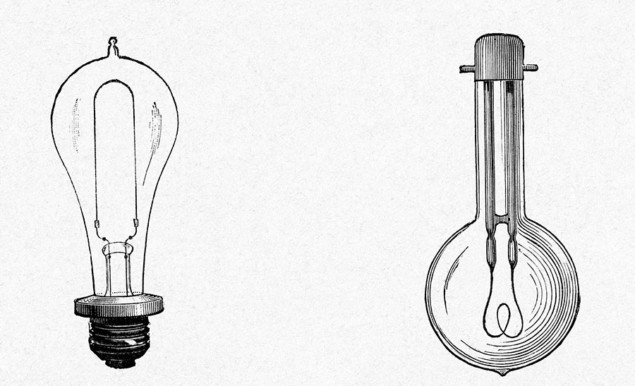In the second of his new columns about physics in industry, James McKenzie looks at the lessons we can learn from the humble light bulb

As you may remember from my column in last month’s issue of Physics World, the editors and I couldn’t initially decide what to call this column and so we put the problem out to readers via Twitter. We offered two options – Transactions or Joseph Swan – and the overwhelming majority chose the former, showing that physicists are clearly more focused on solving a problem than indulging in collective silliness (no Boaty McBoatface for us).
Perhaps if I had put any effort into selling “Joseph Swan” to readers, the name might have got a little further. It isn’t just that a business is like a swan – both look graceful and beautiful from a distance yet face a frantic struggle to take off. More importantly, a column named after Sir Joseph Wilson Swan (1828–1914) would have recognized the efforts of this great British physicist and chemist, who also – you might be surprised to learn – was the inventor of the light bulb.
Swan’s way
Thomas Edison might be the name that people most closely associate with the invention of the light bulb, but it was Swan who was responsible for developing and supplying the electric lights used in the world’s first electrically lit homes and public buildings, including the Savoy Theatre in London, in 1881. Swan had patented his design in 1869 but the trouble with patents is they force you to explain how your invention works. So if you don’t follow through rapidly you can expect competition. And so it proved with the light bulb. Edison’s version, which he patented in 1879, may have merely improved on Swan’s efforts, but ultimately it was more successful.

The business of physics
But why did Swan not do better? After all, the general principle of the incandescent light bulb is simple: if you send an electrical current through a filament, it heats up and glows, producing light. But what’s important is that the interior of the bulb is a vacuum so the filament doesn’t oxidize and lasts a long time. The vacuum in Swan’s bulb was so poor that the filament – made from carbonized paper – disintegrated rapidly and the bulb glowed for barely 15 hours.
Swan’s bulb also had a low resistance, which sounds good until you realize that it meant a high current flowing through the first bulbs. The only practical way to stop the bulb from burning out was therefore to place multiple bulbs in series, but this meant that if one bulb popped, all the lights went out. Swan worked on his bulb product and later patented a better version based on a higher resistance filament at a similar time to Edison – but not before giving his competitors plenty of time to get into the light-bulb business.
Edison had other advantages too. He had a better vacuum pump earlier. He was well funded (from the sale of his telegraph business) and his team tested thousands of materials at his Menlo Park facility in New Jersey, including a higher-resistance filament derived from bamboo. It lasted up to 1200 hours and could be used in parallel circuits, thereby avoiding the all-lights-out-if-one-bulb-pops scenario. And as there was no electrical infrastructure at the time, Edison designed his bulb with the whole system in mind.
Let there be light
To see why Edison’s bulb succeeded, let’s recall the technologies available in the 1880s to deliver light to homes and businesses when the Sun went down. The options were mostly fire based: candles, gas lights and oil lamps. Whale oil was particularly popular as it burned the brightest and didn’t produce much soot – this was a major reason why whales were hunted. The problem was that each source of light had to be individually lit every evening and then put out before you went to bed.
The beauty for businesses was that electric light was a “closed” system, with every manufacturer having their own bulbs, voltages and forms of DC distribution
James McKenzie
Electric light was a revelation. It was clean, relatively safe and multiple lights could be switched on and off simultaneously. In short, everyone wanted it. The beauty for businesses was that it was a “closed” system, with every manufacturer having their own bulbs, voltages and forms of DC distribution. Customers were forced to keep buying from the same firm – Edison’s in Edison’s case.
Edison therefore benefited from four things: a well-thought-through system; a good business model; a working product that was much better than the competition; and patents. As a result, he attracted huge investment from J P Morgan and many others to roll out his electrical DC infrastructure around the world. As the market grew, however, Edison faced growing competition himself, particularly from the alternating-current (AC) system developed by the Westinghouse Electric Corporation. The battle of the currents raged for more than two decades and, ultimately, his DC system itself lost out because AC was better at long-distance transmission.
Lessons from Edison
The physics of both Swan’s and Edison’s bulbs was exactly the same, but it was Edison’s design and product implementation that led him to succeed and spawn a business – General Electric – that is still around today. Yes, Swan patented first and was a successful inventor and entrepreneur. He even sued Edison for patent infringement, with the British courts ruling against Edison, who was forced to make Swan a partner in his UK firm Ediswan. But it is Edison who is recognized as the father of a global revolution.
To succeed in business, you not only need to solve a problem but also work hard on the features and benefits of your product. And that’s why I wanted to call the column Joseph Swan. Still, Transactions is a very good name.



